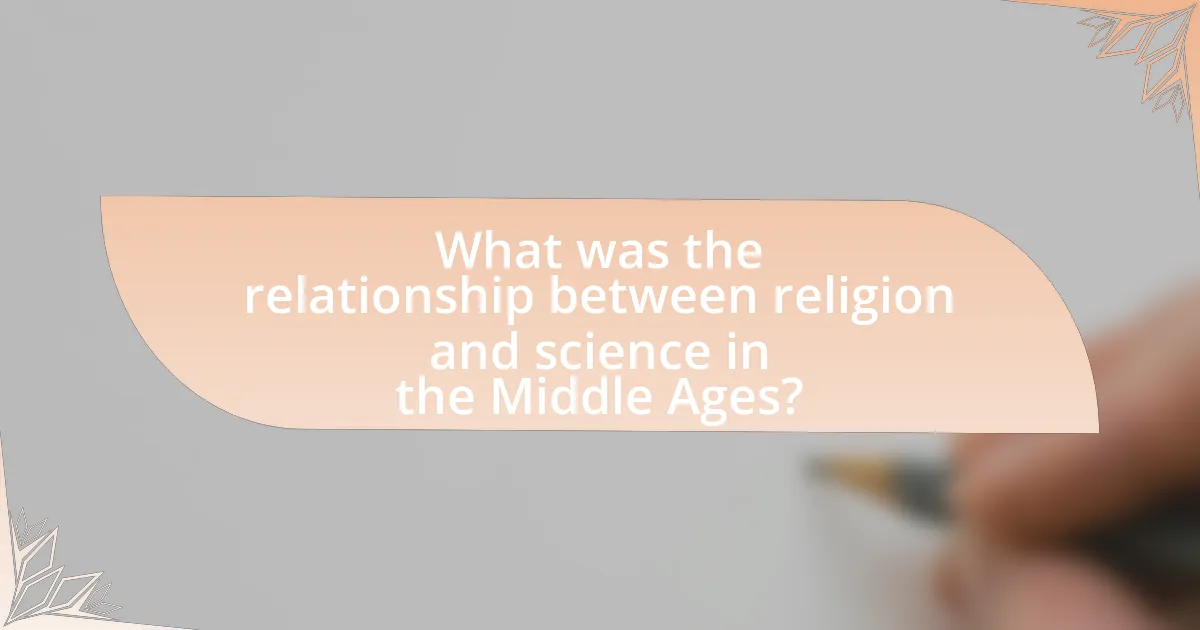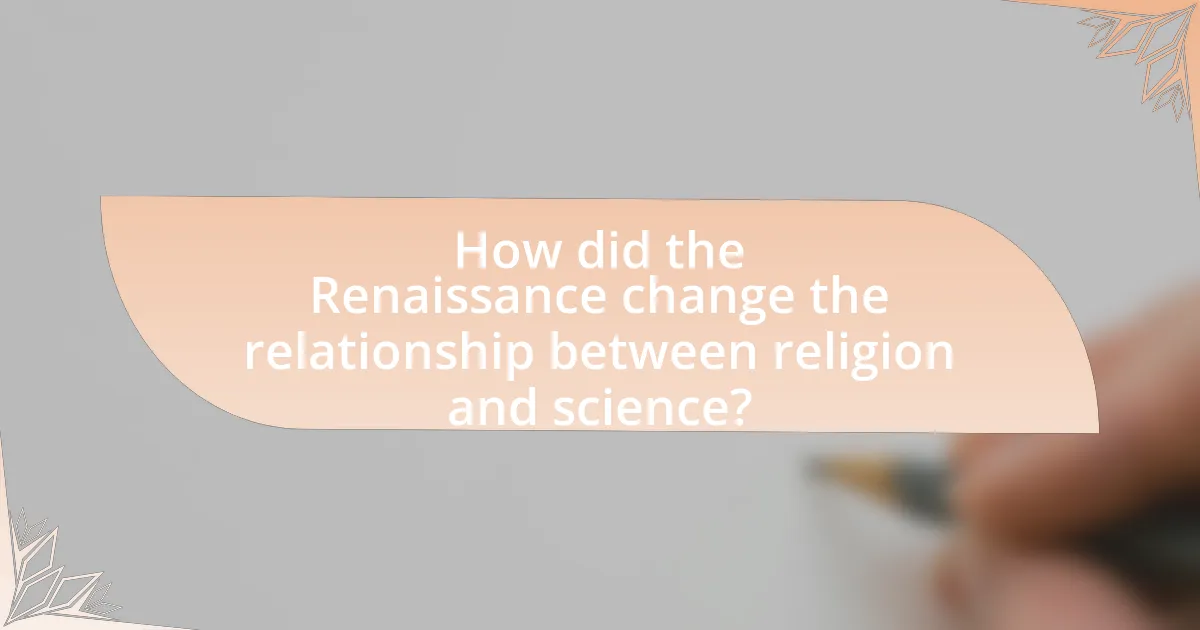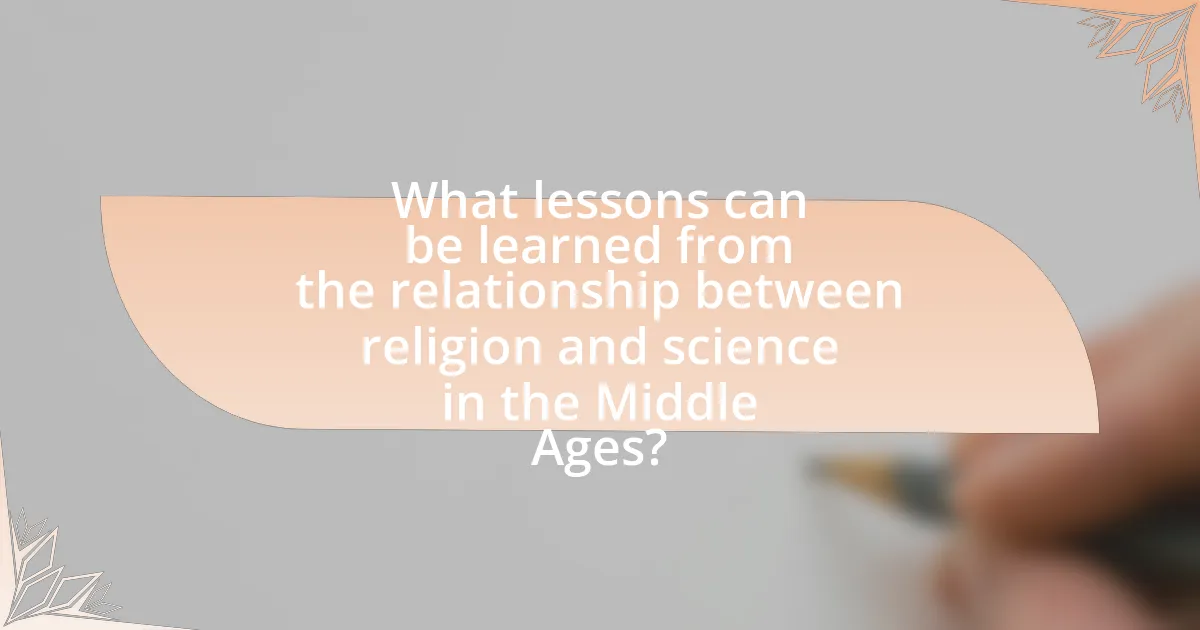The article examines the intricate relationship between religion and science during the Middle Ages, highlighting the Catholic Church’s dominant role in shaping intellectual life and scientific inquiry. It discusses how theological beliefs influenced the understanding of natural phenomena, the establishment of universities, and the preservation of ancient texts, which facilitated scientific advancements. Key figures such as Thomas Aquinas, Roger Bacon, and Galileo Galilei are explored, along with the conflicts that arose between emerging scientific ideas and established religious doctrines. The article also addresses the impact of the Renaissance and the Reformation on this relationship, ultimately emphasizing the lessons learned from this historical context for contemporary debates between science and religion.

What was the relationship between religion and science in the Middle Ages?
The relationship between religion and science in the Middle Ages was characterized by a complex interplay where religion often dominated scientific inquiry. The Catholic Church played a significant role in shaping intellectual life, as it was the primary institution that preserved and transmitted knowledge. Scholars like Thomas Aquinas sought to reconcile faith with reason, arguing that both could coexist harmoniously. However, the Church also imposed restrictions on certain scientific ideas, exemplified by the condemnation of Galileo’s heliocentric theory in the early 17th century. This tension illustrates that while religion provided a framework for understanding the world, it also limited the scope of scientific exploration during this period.
How did religion influence scientific thought during the Middle Ages?
Religion significantly influenced scientific thought during the Middle Ages by providing a framework within which scholars pursued knowledge. The Church was the primary institution of learning, and its teachings shaped the understanding of the natural world. For instance, the works of Aristotle were integrated into Christian theology by scholars like Thomas Aquinas, who argued that reason and faith could coexist, thus encouraging the study of nature as a means to understand God’s creation. Additionally, the establishment of universities, often under ecclesiastical authority, facilitated the study of various disciplines, including medicine and astronomy, which were viewed as ways to explore divine order. This interplay between faith and reason laid the groundwork for later scientific advancements during the Renaissance.
What role did the Church play in the development of scientific ideas?
The Church played a significant role in the development of scientific ideas during the Middle Ages by acting as a primary institution for education and the preservation of knowledge. Monasteries and cathedral schools, established by the Church, became centers for learning where scholars studied ancient texts, including works by Aristotle and Galen, which laid the groundwork for later scientific inquiry. The Church also supported the establishment of universities in the 12th century, which further facilitated the study of natural philosophy, a precursor to modern science. Additionally, while the Church sometimes resisted certain scientific ideas that contradicted its teachings, it also contributed to the scientific method by encouraging systematic observation and the pursuit of knowledge about the natural world. This dual role of support and resistance shaped the trajectory of scientific thought during this period.
How did theological beliefs shape the understanding of natural phenomena?
Theological beliefs significantly shaped the understanding of natural phenomena by framing the interpretation of the natural world through a religious lens. During the Middle Ages, scholars often viewed natural events as manifestations of divine will, leading to explanations that prioritized spiritual significance over empirical observation. For instance, the belief in a geocentric universe, supported by theologians like Thomas Aquinas, positioned Earth at the center of creation, reflecting the theological view of humanity’s central role in God’s plan. This perspective limited scientific inquiry, as natural phenomena were often attributed to supernatural causes rather than explored through observation and experimentation. Historical records indicate that the Church’s authority influenced the acceptance of certain scientific ideas, such as the rejection of heliocentrism proposed by Copernicus, which was seen as conflicting with scriptural interpretations. Thus, theological beliefs not only provided a framework for understanding natural phenomena but also constrained the development of scientific thought during this period.
What were the key scientific advancements during the Middle Ages?
Key scientific advancements during the Middle Ages included the development of universities, the translation of ancient texts, and advancements in fields such as astronomy, medicine, and mathematics. The establishment of universities in the 12th century facilitated the systematic study of various disciplines, leading to the preservation and expansion of knowledge. The translation movement, particularly in Spain and Sicily, allowed for the introduction of works by Aristotle and Galen into Western thought, significantly influencing medieval scholarship. In astronomy, figures like Copernicus began to challenge geocentric models, while in medicine, the works of Avicenna, particularly “The Canon of Medicine,” became foundational texts. Additionally, the introduction of Arabic numerals and algebra from the Islamic world transformed mathematical practices in Europe. These advancements were often intertwined with religious institutions, as many scholars were clerics who sought to reconcile faith with reason.
Which scholars contributed to scientific knowledge in this period?
Scholars such as Thomas Aquinas, Roger Bacon, and Albertus Magnus significantly contributed to scientific knowledge during the Middle Ages. Thomas Aquinas integrated Aristotelian philosophy with Christian theology, emphasizing reason and observation, which laid the groundwork for later scientific inquiry. Roger Bacon advocated for empirical methods and experimentation, arguing for the importance of observation in understanding the natural world. Albertus Magnus, known for his work in natural philosophy, made significant contributions to botany, zoology, and mineralogy, promoting the study of nature as a means to understand divine creation. These scholars collectively advanced the relationship between religion and science, fostering an environment where scientific exploration could thrive within a theological framework.
How did the preservation of ancient texts impact scientific progress?
The preservation of ancient texts significantly impacted scientific progress by ensuring the continuity of knowledge from classical civilizations to the Middle Ages. This continuity allowed scholars to access foundational works in mathematics, astronomy, and medicine, which were essential for further advancements. For instance, the translation of Greek and Roman texts into Arabic and later into Latin facilitated the revival of scientific inquiry in Europe during the 12th century. Notably, the works of Aristotle and Galen were instrumental in shaping medieval thought and laid the groundwork for the Renaissance. The establishment of universities in this period further exemplified the importance of these preserved texts, as they became central to the curriculum, promoting critical thinking and empirical observation.
What conflicts arose between religion and science in the Middle Ages?
Conflicts between religion and science in the Middle Ages primarily revolved around the interpretation of natural phenomena and the authority of religious doctrine. The Catholic Church often opposed scientific ideas that contradicted biblical teachings, such as the heliocentric model proposed by Copernicus, which suggested that the Earth revolves around the Sun rather than the other way around. This conflict culminated in the trial of Galileo Galilei in 1633, where he faced condemnation for advocating heliocentrism, which the Church deemed heretical. Additionally, the Church’s adherence to Aristotelian cosmology clashed with emerging scientific observations, leading to tensions that stifled scientific inquiry and promoted a worldview centered on religious explanations rather than empirical evidence.
What were the major controversies involving scientific discoveries and religious doctrine?
Major controversies involving scientific discoveries and religious doctrine during the Middle Ages included the conflict between heliocentrism and geocentrism, particularly highlighted by Galileo Galilei’s support for the heliocentric model, which contradicted the Church’s geocentric view. This led to Galileo’s trial and house arrest in 1633, as the Catholic Church deemed his findings heretical. Another significant controversy was the opposition to the theory of evolution, which emerged later but has roots in earlier debates about the nature of creation and the interpretation of biblical texts. The trial of Giordano Bruno in 1600, who advocated for an infinite universe and multiple worlds, also exemplified the tension between emerging scientific thought and established religious beliefs. These instances illustrate the broader struggle between faith and reason that characterized the relationship between religion and science during this period.
How did the Inquisition affect scientific inquiry?
The Inquisition significantly hindered scientific inquiry by enforcing strict adherence to religious doctrine, which often contradicted emerging scientific ideas. This suppression of dissenting views led to a climate of fear among scholars, discouraging them from pursuing research that could challenge established beliefs. For instance, the trial of Galileo Galilei in 1633 exemplifies this impact, as he faced condemnation for advocating heliocentrism, which was deemed heretical by the Church. Consequently, the Inquisition’s actions stifled intellectual progress and delayed the acceptance of scientific advancements during the Middle Ages.

How did the Renaissance change the relationship between religion and science?
The Renaissance significantly altered the relationship between religion and science by promoting humanism and empirical observation, leading to a gradual shift from religious dogma to scientific inquiry. During this period, thinkers like Galileo Galilei and Nicolaus Copernicus challenged the geocentric model endorsed by the Church, advocating for heliocentrism based on observational evidence. This shift was further supported by the invention of the printing press, which facilitated the dissemination of new scientific ideas and texts, allowing for broader public engagement and debate. Consequently, the Renaissance laid the groundwork for the Scientific Revolution, which emphasized reason and evidence over faith, ultimately diminishing the Church’s authority in scientific matters.
What shifts occurred in scientific thought during the Renaissance?
During the Renaissance, scientific thought shifted from a reliance on religious dogma to an emphasis on observation and empirical evidence. This period marked the emergence of humanism, which encouraged the study of classical texts and the application of reason to understand the natural world. Key figures such as Nicolaus Copernicus proposed heliocentric models, challenging the geocentric views upheld by the Church. Additionally, advancements in anatomy by Andreas Vesalius and the development of the scientific method by Francis Bacon further exemplified this transition towards a more systematic and evidence-based approach to science, moving away from purely theological explanations.
How did humanism influence the study of science?
Humanism significantly influenced the study of science by promoting a focus on empirical observation and critical thinking, which shifted the intellectual landscape of the Middle Ages. This movement encouraged scholars to seek knowledge through direct experience and reason rather than solely relying on religious doctrine. For instance, humanists like Francesco Petrarch emphasized the value of classical texts, which led to a revival of ancient Greek and Roman scientific works, fostering a more analytical approach to understanding the natural world. This shift is evidenced by the works of scientists such as Nicolaus Copernicus, whose heliocentric model was inspired by humanist principles that prioritized observation and mathematical reasoning over traditional geocentric views upheld by the Church.
What impact did the printing press have on the dissemination of scientific ideas?
The printing press significantly accelerated the dissemination of scientific ideas by enabling the mass production of texts, which made knowledge more accessible. Prior to its invention in the 15th century, scientific works were laboriously copied by hand, limiting their availability and circulation. The printing press allowed for the rapid distribution of important texts, such as Copernicus’s “De revolutionibus orbium coelestium” and Galileo’s works, which challenged established religious doctrines. By the end of the 16th century, thousands of copies of scientific texts were in circulation, fostering a culture of inquiry and debate that was crucial for the Scientific Revolution. This shift not only democratized knowledge but also facilitated the spread of new ideas across Europe, ultimately leading to a gradual separation of scientific inquiry from religious authority.
How did the Reformation affect scientific exploration?
The Reformation significantly advanced scientific exploration by promoting individual inquiry and challenging established authorities. This movement encouraged thinkers to question traditional beliefs and seek empirical evidence, leading to a shift from reliance on religious doctrine to observation and experimentation. For instance, figures like Galileo Galilei and Johannes Kepler emerged during this period, advocating for a scientific approach that emphasized observation of the natural world, which was a departure from the theological explanations that dominated prior to the Reformation. The Reformation’s emphasis on personal interpretation of scripture also fostered an environment where questioning and exploration were more accepted, ultimately contributing to the Scientific Revolution.
What were the responses of different religious groups to scientific advancements?
Different religious groups had varied responses to scientific advancements during the Middle Ages. The Catholic Church often viewed scientific discoveries with skepticism, particularly when they contradicted biblical teachings, as seen in the case of Galileo’s heliocentric theory, which led to his trial and condemnation in 1633. Conversely, Islamic scholars embraced scientific inquiry, contributing significantly to fields such as mathematics, astronomy, and medicine, exemplified by figures like Al-Khwarizmi and Avicenna, who integrated scientific knowledge with religious thought. Jewish scholars, particularly in Spain, also engaged with scientific advancements, translating and preserving Greek and Arabic texts, which facilitated the transmission of knowledge. These responses illustrate the complex interplay between faith and reason during this period.
How did the Protestant Reformation challenge the Catholic Church’s authority over science?
The Protestant Reformation challenged the Catholic Church’s authority over science by promoting individual interpretation of the Scriptures and encouraging critical thinking. Reformers like Martin Luther and John Calvin emphasized personal faith and the importance of direct engagement with biblical texts, which undermined the Church’s role as the sole interpreter of religious and scientific knowledge. This shift led to a questioning of established doctrines, including those related to natural philosophy and the scientific understanding of the world. The Reformation’s emphasis on reason and empirical evidence contributed to the rise of scientific inquiry, as seen in the works of figures like Galileo Galilei, who faced opposition from the Church for advocating heliocentrism. Thus, the Reformation not only redefined religious authority but also laid the groundwork for the Scientific Revolution by promoting a culture of inquiry and skepticism towards traditional teachings.

What lessons can be learned from the relationship between religion and science in the Middle Ages?
The relationship between religion and science in the Middle Ages teaches that both can coexist and influence each other, despite apparent conflicts. During this period, the Catholic Church played a significant role in preserving and promoting scientific knowledge, as seen in the establishment of universities and the translation of ancient texts. Notably, figures like Thomas Aquinas integrated Aristotelian philosophy with Christian theology, demonstrating that faith and reason could complement one another. Additionally, the Church’s support for astronomy, exemplified by scholars such as Copernicus, highlights how religious institutions contributed to scientific advancements. This historical context illustrates that collaboration between differing worldviews can lead to intellectual growth and societal progress.
How can the historical relationship inform current debates between science and religion?
The historical relationship between science and religion, particularly during the Middle Ages, can inform current debates by illustrating how both domains have coexisted and influenced each other over time. For instance, during the Middle Ages, scholars like Thomas Aquinas integrated Aristotelian philosophy with Christian theology, demonstrating that faith and reason could coexist. This historical precedent shows that contemporary discussions can benefit from recognizing the potential for dialogue between scientific inquiry and religious belief, rather than viewing them as inherently opposed. Additionally, the conflict model, often exemplified by the Galileo affair, highlights the complexities and tensions that can arise, suggesting that current debates should consider historical contexts to avoid repeating past mistakes. Understanding these dynamics can foster a more nuanced approach to the ongoing discourse between science and religion today.
What parallels exist between past and present conflicts in science and religion?
Parallels between past and present conflicts in science and religion include the struggle over the interpretation of natural phenomena and the resistance to scientific advancements that challenge established religious doctrines. Historically, the trial of Galileo in the 17th century exemplified how the Catholic Church opposed heliocentric theories, reflecting a broader tension between empirical evidence and theological beliefs. Similarly, contemporary debates over topics like evolution and climate change illustrate ongoing conflicts where scientific consensus often clashes with religious interpretations, leading to societal divisions. These instances demonstrate a recurring theme where both historical and modern contexts reveal a fundamental discord between faith-based perspectives and scientific inquiry.
How can dialogue between science and religion be fostered today?
Dialogue between science and religion can be fostered today through interdisciplinary collaboration and open communication. Initiatives such as joint conferences, workshops, and educational programs that include both scientists and religious leaders can create a platform for shared understanding. For instance, organizations like the American Association for the Advancement of Science have established programs that encourage dialogue between scientists and faith communities, demonstrating that collaborative efforts can lead to mutual respect and learning. Additionally, promoting literature that explores the compatibility of scientific discoveries with religious beliefs can further bridge gaps, as seen in works by authors like John Polkinghorne, who articulate a harmonious relationship between the two fields.
What best practices can be adopted for integrating scientific and religious perspectives?
Best practices for integrating scientific and religious perspectives include fostering dialogue between scientists and religious leaders, promoting interdisciplinary education, and encouraging critical thinking. Dialogue allows for mutual understanding and respect, as seen in historical collaborations like those between medieval scholars and theologians, which facilitated the exchange of ideas. Interdisciplinary education can help students appreciate both scientific inquiry and religious beliefs, as demonstrated by curricula that include both science and philosophy. Encouraging critical thinking enables individuals to analyze and reconcile differing viewpoints, which is essential for a harmonious relationship between science and religion.